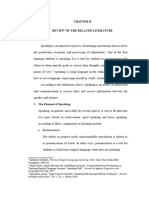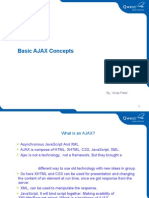Elt 02 2.0
Elt 02 2.0
Uploaded by
Magsino KhyllOriginal Description:
Original Title
Copyright
Available Formats
Share this document
Did you find this document useful?
Is this content inappropriate?
Report this DocumentCopyright:
Available Formats
Elt 02 2.0
Elt 02 2.0
Uploaded by
Magsino KhyllCopyright:
Available Formats
ELT 02
The Communicative Approach
Magsino, Khyll Nicole R. III-H2
Introduction
Communicating using a foreign language is difficult as well as teaching it. The
communicative approach or Communicative Language Teaching (CLT) is a useful way of
teaching a foreign language, which is the primary goal to ensure that the students can
communicate using the target language (in our case as AB English students is the use and
understanding of English). To achieve this goal, the students should participate and
communicate actively using the target language. Practice makes it perfect right?
Unfortunately, the present classroom routines do not always align with the intended
outcomes. Instead of using modern approaches in teaching, some teachers stick to the
traditional approach, the teacher-centred approach, in which the teacher is always the one
talking and the learners are always listening only. Communicative approach is a learner-
centered approach. The roles of the teacher and the learner is reversed, the learner will do all
the talking and the teacher will be listening ang guiding the learner.
What is the Communicative Approach?
Communicative approach that emerged in the 1960's in Europe, is a teaching approach
that highlights the importance of real communication. Aside from grammatical competence, it
also develops the learner's competence to communicate using the target language. It is a
learner-centred approach that gives the learner a social skill as to what to say, how to say, when
and where to say such language to satisfy his/her needs.
The communicative approach, which originally began as a reaction to the grammatical
translation method, depends on the notion that mastering a language requires the ability to
express meaningful ideas. It places less emphasis on the learning of specific grammatical rules
and more on obtaining native-speaker-like fluency and pronunciation. Students are assessed on
their level of communicative competence rather than on their explicit knowledge. The learners’
natural strategies for language acquisition will be used, and this will allow them to learn to use
the language.
Elements of Communicative Approach
According to David Nunan, there are five key elements to the communicative approach.
1. An emphasis on learning to communicate through interaction in the target
language.
The learners should be active in interacting with other learners, as well as with
their teachers, using the target language. Instead of memorizing the rules of grammar,
practising the target language should be the focus of communication. This can be done
in various activities like pair or group work, roleplaying, debates, discussions and many
more activities.
2. The introduction of authentic texts into the learning situation
The introduction of authentic texts into the learning situation can be a valuable
way to help learners develop their language skills, and exposure to real-world language,
helping them to understand the texts and giving them opportunities to interact with the
texts. The teachers can also help the learners to become more proficient in the
language. Some examples of authentic texts are newspapers, books, songs, interviews,
and speeches.
3. The provision of opportunities for learners to focus, not only on the language but
also on the learning process itself.
When we learn a new language, we are not just learning vocabulary and
grammar. We are learning how to think in that language. This includes learning how to
process information, how to make connections, and how to solve problems. This can be
done through various activities such as reflections, self-assessment, collaboration, and
problem-solving.
4. An enhancement of the learners' own experiences as important contributing
elements to classroom learning
Teachers can help the learners develop a deeper understanding of the material,
develop critical thinking and communication skills, and connect their own lives. It can
also help in creating a more inclusive and welcoming classroom environment. When
learners feel that their experiences are valued and respected, they are more likely to feel
engaged and motivated to learn.
5. An attempt to link classroom language learning with language activation outside
the classroom.
It is about helping learners see how what they learn in the classroom can be used
and applied in the real world. Teachers can help the learners to develop the language in
real-world contexts.
Communicative Competences
There are eight aspects of communicative competencies and are grouped into two
parts: The Linguistic Aspect and the Pragmatic Aspect.
The linguistic aspect focuses on the use of language in communication. The competencies
under the linguistic aspect are the following:
a. Phonology and grammar description
b. Grammar
c. Vocabulary
d. Discourse
The pragmatic aspect, on the other hand, focuses on the use of language in social contexts.
The competencies under the pragmatic aspect are the following:
a. Functions
b. Variations
c. Interaction skill
d. Cultural framework
Characteristics of the Communicative Approach
1. Focus on meaning
The communicative approach focuses on helping learners to communicate
effectively in real-world contexts. This means that teachers focus on teaching learners how
to use language to express their ideas and needs, rather than simply memorizing
grammatical rules.
2. Use of communicative activities
The communicative approach emphasizes the use of communicative activities and tasks in
the classroom. These activities and tasks allow learners to practice using the language in a
way that is similar to how they would use it in the real world.
3. Use of authentic materials
The communicative approach also emphasizes the use of authentic materials in the
classroom. Authentic materials are materials that are used by native speakers of the target
language. This could include newspapers, magazines, websites, and videos.
4. Focus on fluency and meaning
The communicative approach emphasizes the importance of fluency and meaning
over accuracy. This means that teachers focus on helping learners to be able to
communicate effectively, even if they make some mistakes.
5. Role of the teacher
The role of the teacher in the communicative approach is to facilitate learning and
provide learners with opportunities to practice using the language. Teachers do not focus on
correcting learners' mistakes, but rather on providing them with feedback on their
communication skills.
References:
What is the Communicative Approach by Andreia Zakime in August 23, 2018. Retrieved:
September 11, 2023.
https://www,whatiselt.com/single-post/2018/08/23/What-is-the-Communicative-Approach
Communicative Approach by Col Muhammad Khalid Khan. Retrieved: September 11, 2023.
https://www.slideshare.net/tauqueerkhalidkhan/Communicative-approach-35870321
Communicative Approach by British Council. Retrieved: September 11, 2023.
https://www.teachingenglish.org.uk/professional-development/teachers/knowing-subject/c/
communicative-approach
What is Communicative Approach by LinguistikId on February 24, 2017. Retrieved: September
11, 2023.
Https://www.linguistikid.com/what-is0communicative-approach/
Communicative Approach by Teflpedia in March 30, 2012. Retrieved: September 15, 2023.
https://teflpedia.com/index.php?title=Communicative_Approach&veaction=edit
Communicative Approach by The Blessed Professor. Retrieved: September 15, 2023.
https://www.youtube.com/watch?v=JRm-jQ0CJk
What is Communicative Approach, its Main Features, and Sample Activities to Use in EFL/ESL
Classes by M. Elkadaouie in July 1, 2018. Retrieved: September 15, 2023
https://moroccoenglish,com/communicative-approach
The Communicative Approach (CLT) – How to Improve the ESL Classroom by Erin H. in
October 10, 2020. Retrieved: September 15, 2023
https://makostars.com/esl-communicative-approach/#:~:text=Here%20are%20some%20key
%20features%20of%20the%20communication,Less%20emphasis%20on%20error
%20correction%200...%20More%20items
You might also like
- Strategies for Teaching English Language, Literature, and ContentFrom EverandStrategies for Teaching English Language, Literature, and ContentRating: 5 out of 5 stars5/5 (3)
- Messaging: beyond a lexical approach in ELTFrom EverandMessaging: beyond a lexical approach in ELTRating: 5 out of 5 stars5/5 (1)
- The Four Writing Purpose Triplets RevisionDocument3 pagesThe Four Writing Purpose Triplets RevisionKarimat AlagbeNo ratings yet
- Richard Powers-Galatea 2.2Document165 pagesRichard Powers-Galatea 2.2Prashant SinghNo ratings yet
- Makalah Teaching SpeakingDocument15 pagesMakalah Teaching Speakingika dewi100% (13)
- Ab Initio TrainingDocument103 pagesAb Initio Trainingsuperstarraj63% (8)
- Group4 ETMDocument16 pagesGroup4 ETMCutt SyarfNo ratings yet
- What Is The Communicative Approach?Document5 pagesWhat Is The Communicative Approach?Brenda PalaciosNo ratings yet
- Communicative Language TeachingDocument8 pagesCommunicative Language Teachingadnan.heffafNo ratings yet
- Communicative Approach Group 8 Tefl AryaDocument6 pagesCommunicative Approach Group 8 Tefl AryaM. AryaNo ratings yet
- Module-Language Learning Materials DevelopmentDocument7 pagesModule-Language Learning Materials DevelopmentLyn PalmianoNo ratings yet
- The Communicative ApproachDocument9 pagesThe Communicative Approachema_mirela88100% (2)
- Communicative Aproach.Document6 pagesCommunicative Aproach.belenNo ratings yet
- Communicative ApproachDocument9 pagesCommunicative ApproachAmal OmarNo ratings yet
- The Communicative ApproachDocument11 pagesThe Communicative ApproachІрина МиськівNo ratings yet
- Activity and CommunicativeDocument11 pagesActivity and CommunicativeSafaa Mohamed Abou KhozaimaNo ratings yet
- Methods of Teaching Thursday 12/8/2020: The Principles of GTMDocument6 pagesMethods of Teaching Thursday 12/8/2020: The Principles of GTMdunia duniaNo ratings yet
- B.inggris Work Sheet 1-10 AnnisaaFirdausDocument15 pagesB.inggris Work Sheet 1-10 AnnisaaFirdausRaismanNo ratings yet
- Thesis From ICCTDocument74 pagesThesis From ICCTLeo Estrella PlacidoNo ratings yet
- Communication ApproachDocument7 pagesCommunication Approachbulbulkarn0418No ratings yet
- Communicative ApproachDocument7 pagesCommunicative ApproachNay YaniNo ratings yet
- Communicative CompetenceDocument15 pagesCommunicative CompetencePacurar EmmaNo ratings yet
- Module 3. A Brief History of Language Teaching 2Document10 pagesModule 3. A Brief History of Language Teaching 2Memy Muresan100% (1)
- 1the Principles of Communicative Language TeachingDocument2 pages1the Principles of Communicative Language TeachingSimeonov AlinaNo ratings yet
- CLT Report and Answer Realated QuestionDocument7 pagesCLT Report and Answer Realated QuestionNgan NguyenNo ratings yet
- Communicative Learning Teaching ...Document4 pagesCommunicative Learning Teaching ...ozypics6858No ratings yet
- Articol CLT BunDocument10 pagesArticol CLT BunLoredana ScarlatescuNo ratings yet
- Topic 14. EFLDocument16 pagesTopic 14. EFLAntonioNo ratings yet
- Mata Kuliah: TEFL 1 NAMA: Rusli Abednego NIM: 041674729: 1. Natural Aprroach Teaching MethodDocument7 pagesMata Kuliah: TEFL 1 NAMA: Rusli Abednego NIM: 041674729: 1. Natural Aprroach Teaching MethodRusli AbednegoNo ratings yet
- Content-Based, Task-Based, and Participatory Approach SLIDESDocument26 pagesContent-Based, Task-Based, and Participatory Approach SLIDESMoises Ramirez50% (2)
- HMLB021Document3 pagesHMLB021mashabalerato26No ratings yet
- ELT Assignment 4th SemesterDocument7 pagesELT Assignment 4th SemesterAio AlzaidanyNo ratings yet
- Module in Approaches For Language Arts TeachingDocument6 pagesModule in Approaches For Language Arts TeachingrosevicabangayNo ratings yet
- Outline The Communicative Approach To Second Language TeachingDocument8 pagesOutline The Communicative Approach To Second Language TeachingliadhanNo ratings yet
- Current Trends in Language TeachingDocument18 pagesCurrent Trends in Language TeachingMery Endriani100% (1)
- Chapter 2Document8 pagesChapter 2abdul hamidNo ratings yet
- A. Communicative Language TeachingDocument7 pagesA. Communicative Language TeachingilhamNo ratings yet
- Communicative Language TeachingDocument4 pagesCommunicative Language TeachingAtiexna Cuitz Cuitz IINo ratings yet
- Task Based Language TeachingDocument13 pagesTask Based Language TeachingSupansa SirikulNo ratings yet
- Content FixDocument43 pagesContent FixMilah Nur Al KhalisaNo ratings yet
- Communicative Language Teaching - 2022 - PART IIDocument33 pagesCommunicative Language Teaching - 2022 - PART IIChristina AgnadaNo ratings yet
- Final Assignment AlDocument9 pagesFinal Assignment AlHiền Anh NguyễnNo ratings yet
- Comunicative ApproachDocument9 pagesComunicative ApproachDiana Valeryn Mamani MasNo ratings yet
- ModernismDocument7 pagesModernismSimona SymonyciNo ratings yet
- Resumen Del Contenido de La Unidad 1 Communicative Language Teaching MethodsDocument9 pagesResumen Del Contenido de La Unidad 1 Communicative Language Teaching MethodsRoberto AlarcónNo ratings yet
- Task 1Document7 pagesTask 1Nestor AlmanzaNo ratings yet
- Communicative Language TeachingDocument20 pagesCommunicative Language TeachingAron EstorninosNo ratings yet
- Communicative Language Teaching A. Proponent: Primarily OnDocument3 pagesCommunicative Language Teaching A. Proponent: Primarily OnHadjirayya BangasinNo ratings yet
- ELT ApproachesDocument10 pagesELT ApproachesRSoundararajanengNo ratings yet
- Characteristics of Communicative Language Teaching English Language EssayDocument13 pagesCharacteristics of Communicative Language Teaching English Language EssayFabián Becerra DíazNo ratings yet
- Proposal 1Document18 pagesProposal 1VeraNo ratings yet
- Communicative Language Tea Ching (CLT)Document51 pagesCommunicative Language Tea Ching (CLT)Mardhiyatun NisaNo ratings yet
- Communicative TeachingDocument10 pagesCommunicative TeachingthemardiezNo ratings yet
- Communicative Language Teaching Effective Teaching Is Not About A MethodDocument7 pagesCommunicative Language Teaching Effective Teaching Is Not About A MethodValerie Acosta RodriguezNo ratings yet
- Compilation of ApproachDocument25 pagesCompilation of ApproachKenzzy DazheriaNo ratings yet
- #2 Canale and SwainDocument5 pages#2 Canale and SwainKRISTELLE COMBATERNo ratings yet
- Secondlanguageteachingmethods 100120082950 Phpapp02Document24 pagesSecondlanguageteachingmethods 100120082950 Phpapp02msooflooNo ratings yet
- Make Up SummariesDocument11 pagesMake Up SummariesPri CanchiNo ratings yet
- Speaking-1 Ka Ofi, Monic, j2nDocument8 pagesSpeaking-1 Ka Ofi, Monic, j2nMuhamad jejen NuraniNo ratings yet
- Empowering Multilingual Learners: Strategies for Inclusive EdcuationFrom EverandEmpowering Multilingual Learners: Strategies for Inclusive EdcuationNo ratings yet
- Conversation Strategies: Pair and Group Activities for Develping Communicative CompetenceFrom EverandConversation Strategies: Pair and Group Activities for Develping Communicative CompetenceRating: 4.5 out of 5 stars4.5/5 (3)
- Basic Ajax ConceptsDocument16 pagesBasic Ajax Conceptsapi-3829446No ratings yet
- Opera Client With Microsoft EdgeDocument19 pagesOpera Client With Microsoft Edgecikrg remoteNo ratings yet
- Pref - 4 - Grammar 2.4 - Revisión Del IntentoDocument5 pagesPref - 4 - Grammar 2.4 - Revisión Del IntentoJessica Tatiana CARVAJAL CARDONANo ratings yet
- ACOS 5.2.1-P3 System Configuration and Admin-Istration GuideDocument376 pagesACOS 5.2.1-P3 System Configuration and Admin-Istration GuideВыползень СемечкинNo ratings yet
- (Gauss) Lin, Kuan-Pin - 2001 - Computational Eco No Metrics. GAUSS Programming For Econometricians and Financial AnalystsDocument375 pages(Gauss) Lin, Kuan-Pin - 2001 - Computational Eco No Metrics. GAUSS Programming For Econometricians and Financial AnalystsjrodaschNo ratings yet
- HamletDocument41 pagesHamletpericapanNo ratings yet
- Indah Olivia FyDocument2 pagesIndah Olivia FyIcha NuriNo ratings yet
- ESP 10 LAS Quarter 3Document59 pagesESP 10 LAS Quarter 3Mikael TuazonNo ratings yet
- Twitter Business Guide: Communication and Marketing: 2012 Revised and Updated VersionDocument39 pagesTwitter Business Guide: Communication and Marketing: 2012 Revised and Updated VersionScott Monty100% (3)
- Introduction To Business CommunicationDocument43 pagesIntroduction To Business CommunicationSandeep100% (3)
- Energy Data Management: SAP Solution in Detail SAP For UtilitiesDocument20 pagesEnergy Data Management: SAP Solution in Detail SAP For UtilitieschiboogimanNo ratings yet
- Upload and Retrieve Image On MongoDB Using Mongoose - GeeksforGeeksDocument10 pagesUpload and Retrieve Image On MongoDB Using Mongoose - GeeksforGeeksOdoch HerbertNo ratings yet
- ZE550KL Update Error Temporary FixDocument7 pagesZE550KL Update Error Temporary FixИгорь КуприяновNo ratings yet
- Week 1 Lesson Plan RW ENGL 112Document5 pagesWeek 1 Lesson Plan RW ENGL 112وائل الصاويNo ratings yet
- Assigment # 01:: SIR Hasnat ALIDocument16 pagesAssigment # 01:: SIR Hasnat ALIMajidNo ratings yet
- Ma 722 01 en 00Document196 pagesMa 722 01 en 00Hector Martinez100% (1)
- (Free Scores - Com) - Traditional Wish You Merry Christmas 86714 PDFDocument7 pages(Free Scores - Com) - Traditional Wish You Merry Christmas 86714 PDFJoanNo ratings yet
- 3 EnglishDocument17 pages3 EnglishMalsawmkima Maski-a100% (1)
- Terjemahan Tafsir Ibnu Kathir - Surah Al Baqarah Ayat 21 - 22 PDFDocument73 pagesTerjemahan Tafsir Ibnu Kathir - Surah Al Baqarah Ayat 21 - 22 PDFUbay SNo ratings yet
- Media PlayerDocument5 pagesMedia PlayerMartinez GizelleNo ratings yet
- Imperative: Go Take Cross GoDocument1 pageImperative: Go Take Cross GoIsabel Llucho GonzalesNo ratings yet
- 31725H Unit6 Pef 20190814Document25 pages31725H Unit6 Pef 20190814hello1737828No ratings yet
- Karma Vipaka (Sinhala)Document108 pagesKarma Vipaka (Sinhala)TRB94% (16)
- Takwim Panitia Bahasa InggerisDocument5 pagesTakwim Panitia Bahasa Inggerisediharianto100% (1)
- Sample ValidationDocument10 pagesSample ValidationJordy Mae BaguinangNo ratings yet
- Annadaneshwari Resume FlipkartDocument1 pageAnnadaneshwari Resume FlipkartAnnadaneshwari SoraturNo ratings yet
- CSS 12 Module 1Document3 pagesCSS 12 Module 1Jon Jon Redoblado RosalesNo ratings yet

























































































